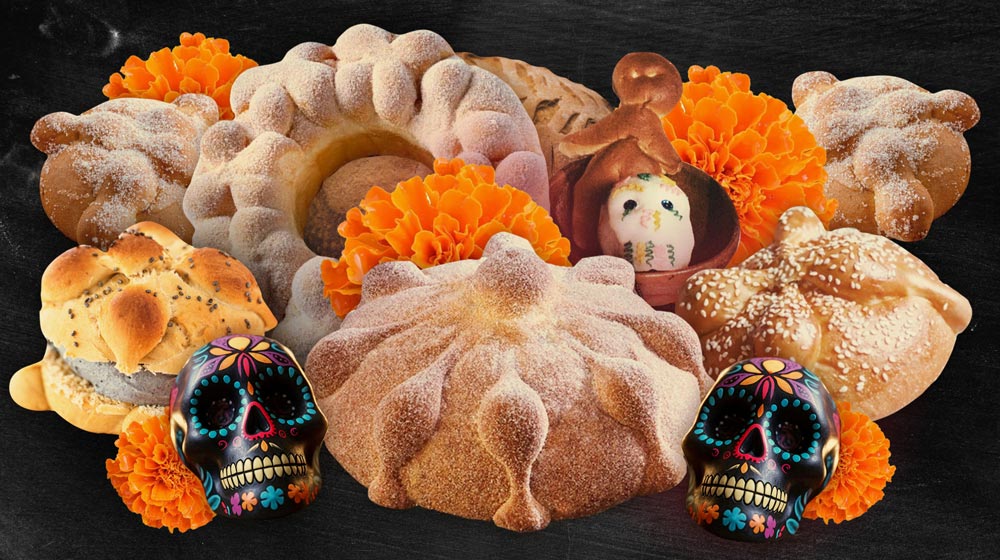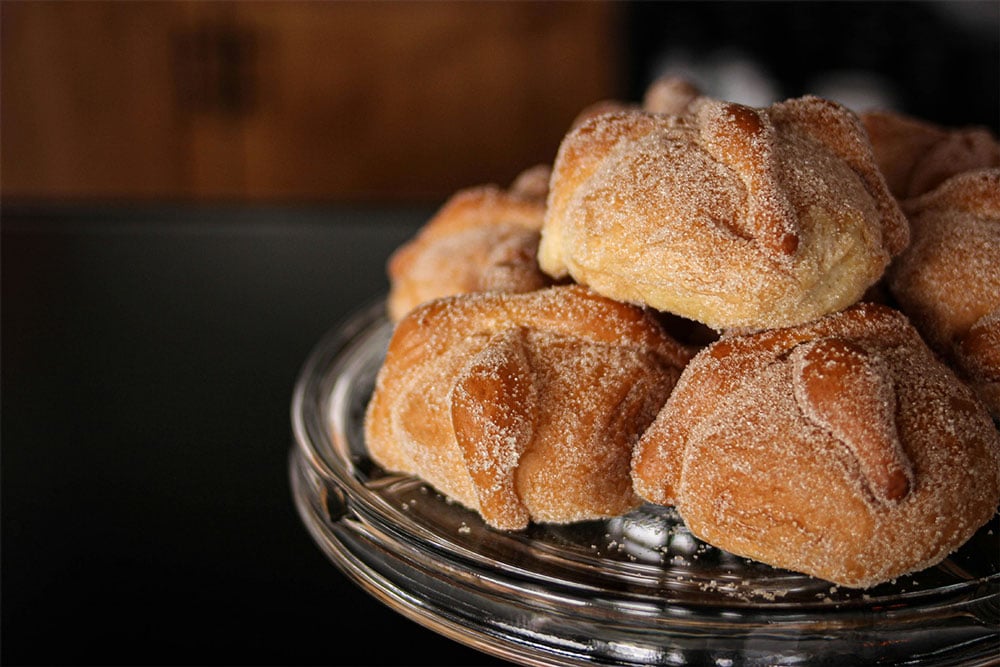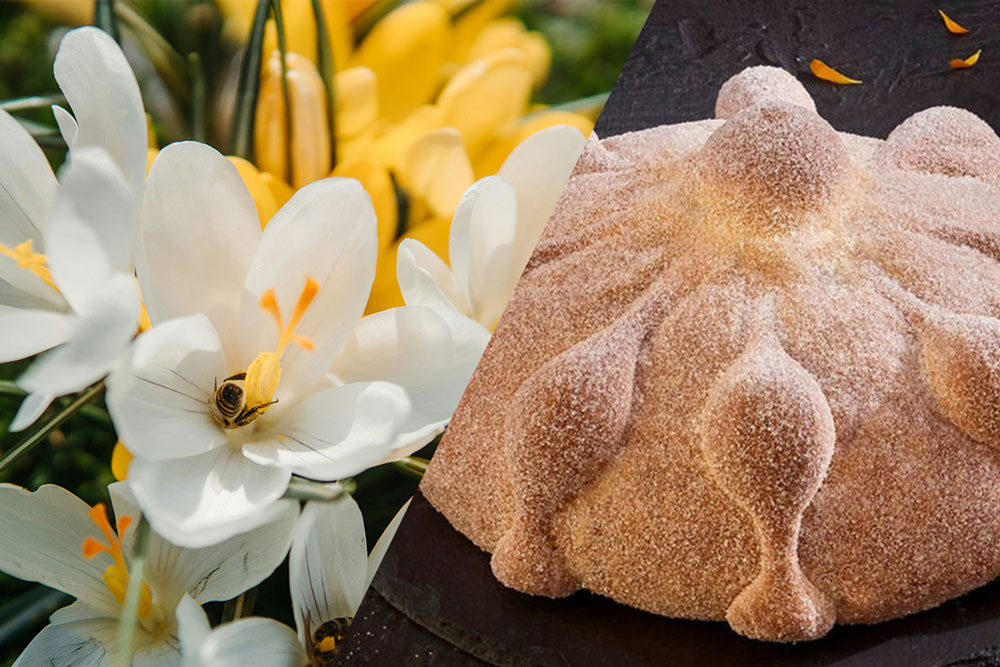Pan de Muerto: Mexico’s Sweetest Ritual

The most symbolic season of the year is here: Día de Muertos. On every altar, surrounded by cempasúchil flowers, candles, and shots of tequila, there is one thing that can never be missing: pan de muerto. A blend of history, faith, and sweetness, it is much more than a dessert. It is an edible offering to the memory of those we love most.
A Bread Born Between Two Worlds
Mexico has breads that tell stories, but none as profound as pan de muerto. According to the National Institute of Indigenous Peoples (INPI) and the research of Vargas Muñoz and García Gómez (2017), this bread represents the fusion of two universes: the pre-Hispanic ceremonies dedicated to the dead and the Christian tradition of the Eucharistic bread.
Before wheat and sugar, Mesoamerican civilizations offered foods made from amaranth and corn. Among them was the papalotlaxcalli or “butterfly bread,” a tortilla stamped with a butterfly seal, painted with bright colors, and symbolizing the souls that returned. There were also amaranth breads shaped like lightning bolts called xonicuille, the yotlaxcalli made from toasted corn, and ceremonial tamales called xucuientlamatzoalli.
Legend says that in ancient rituals, a princess or maiden was sacrificed to the gods. Her still-beating heart was placed over amaranth and bitten by the ritual leader. The Spanish, horrified by the scene, reinterpreted the gesture by creating a wheat bread shaped like a heart, covered with red sugar to symbolize the blood.
The Gods Have Their Bread Too
The pan de muerto we know today still carries those ancient symbols. Its round shape represents the cycle of life and death, the center symbolizes a skull, and the cross-shaped “bones” evoke the four cardinal points dedicated to the gods Quetzalcóatl, Tláloc, Xipe Tótec, and Tezcatlipoca.
White sugar represents bones, while pink or red sugar represents blood and rebirth. On every altar, that round loaf becomes a spiritual map, a reminder that death is not the end but a passage to another life.
And of course, no altar is complete without its glass or caballito, because tequila, just like the bread, is a bridge between two worlds. One ferments the earth, the other the soul.

One Country, Hundreds of Versions
In Mexico, more than 800 varieties of pan de muerto have been documented, each region giving it its own twist.
- In Aguascalientes, it is typically round or oval and can weigh up to 2 kilograms.
- In Mexico City and Estado de México, it is decorated with crossed bones and pink or white sugar, evoking pre-Hispanic tombs.
- In Mixquic, bakeries offer the famous despeinadas, small, sugar-covered rings, and breads embroidered with dough crosses.
- In other parts of Estado de México, bakers prepare muertes (anthropomorphic breads made with egg yolk and cinnamon), triangular tlaxcales made of corn, caladillas with butter and sugar, and sweet quesadillas filled with piloncillo and cheese.
- In Texcoco, the “conejo bread” shines with lard, nuts, guava, and cinnamon.
- In Guerrero, bakers make almas, burros, and animal-shaped breads.
- In Teloloapan, the breads, shaped like fish, dogs, or scorpions, are dedicated to deceased children.
- In Hidalgo, moriscas are made with flour, egg, cinnamon, and pulque (yes, a true drink of the gods).
- In the Huasteca region, pan peluca is shared during the nine-day mourning period.
- In Tula, gorditas of corn kneaded with anthill sand recall the myth of Quetzalcóatl descending into the underworld.
- In Guanajuato, especially Acámbaro, the breads take the shape of “souls,” human figures glazed in white with a pink dot at the center.
- In Michoacán, the famous pan de hule, round and shiny, carries dedications to the departed; corundas recall the indigenous origin of corn, and the knee of Christ is covered in pink sugar to symbolize the Savior’s wounds.
- In Oaxaca, the flaky regañadas represent souls, and the egg-yolk bread with sesame seeds or painted faces honors both adults and children.
- In Puebla, colorful golletes and sequillos de yema complete the altar.
The Recipe for The Soul with A Touch of Orange Blossom

Traditional pan de muerto is made with wheat flour, milk, egg yolks, butter, sugar, orange blossom essence, and orange zest. That essence is not a coincidence: orange blossom evokes the scent of funerals and cherished memories.
Preparing it is almost a ritual:
- Warm milk is mixed with yeast and flour to form a “sponge.”
- Eggs, butter, sugar, zest, and essence are added.
- The dough is kneaded, left to rise, and shaped into bones and a skull.
- It is baked at 180°C (350°F), then brushed with melted butter and sprinkled with sugar.
And yes, the best moment to enjoy it is when your kitchen smells like orange and butter.
Pan de Muerto and Día de Muertos: A Heavenly Pairing
Día de Muertos is not a farewell; it is a toast. In 2003, UNESCO declared it an Intangible Cultural Heritage of Humanity, and pan de muerto is its edible emblem. Every year, with every oven lit, Mexico renews its pact with those who have departed.
On each altar, beside the bread and flowers, there is often a shot of the deceased’s favorite tequila. Bread and drink both come from Mexican soil, one from wheat and sugar, the other from agave and fire. Together, they tell the same story: the story of a country that celebrates life even in the face of death.
Because pan de muerto, like tequila, is not eaten or drunk with sadness but with gratitude. As long as there is a crumb of bread and a sip of tequila on the altar, no soul will ever be truly gone.

